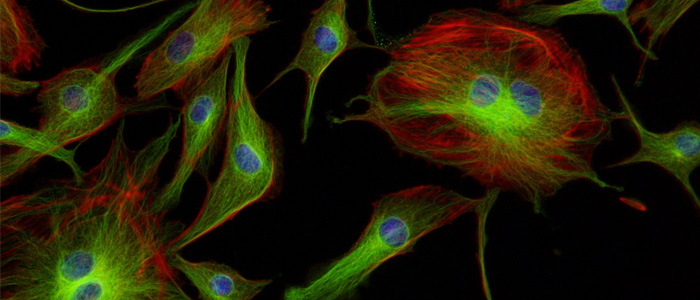How did research benefit from CoolLED Illumination Systems in 2020?

It’s always exciting to read about the research our microscope LED light sources play a part in, and despite the challenges for researchers last year, over 120 ground-breaking papers made it through to publication! We sadly cannot include mention of them all (you can view all at PubMed Central), but here are a few examples:
- Live cell imaging may be one of the best ways to help answer a biological question, but this is easier said than done when it comes to thermophiles, which thrive in temperatures up to 122 °C. The researchers therefore created their Sulfoscope setup for high-temperature imaging, which uses a CoolLED pE-4000 for illumination. This enabled the discovery of molecular characteristics of archaea which are also intriguingly similar to mammalian cells, and we can’t wait to learn about future discoveries unlocked by the new Sulfoscope technology.
Pulschen, A. A. et al. (2020). Live Imaging of a Hyperthermophilic Archaeon Reveals Distinct Roles for Two ESCRT-III Homologs in Ensuring a Robust and Symmetric Division. Current biology : CB, 30(14), 2852–2859.e4. https://doi.org/10.1016/j.cub.2020.05.021
- The presence of saturated fatty acids damages pancreatic β-cells (known as lipotoxicity), which is one of the features of Type 2 Diabetes. Elevated Ca2+ concentrations in the cytosol are known to trigger apoptosis, and it was also observed that the mitochondria takes up Ca2+ via the MCU protein – but what role does this play in lipotoxicity? This researched used RNA interference of the MCU protein together with Fura-2 ratiometric calcium imaging using the CoolLED pE-340fura Illumination System to find the answer. The findings suggest that it is actually a protective mechanism, reducing cytosolic Ca2+ concentrations and protecting the β-cells, presenting a new insight into this prevalent metabolic disease.
Ly, L. D., et al. (2020). Mitochondrial Ca2+ Uptake Relieves Palmitate-Induced Cytosolic Ca2+ Overload in MIN6 Cells. Molecules and cells, 43(1), 66–75. https://doi.org/10.14348/molcells.2019.0223
- Bacterial biofilms make it extremely challenging to treat many infections, and this research might just have found the Achilles Heel. If these newly discovered channels can take up nutrients, why not drugs? The authors used their Mesolens microscope with a 6 mm field of view, which uses the CoolLED pE-4000.
Rooney, LM. et al. (2020). Intra-colony channels in E. coli function as a nutrient uptake system. The ISME journal, 14(10), 2461–2473. https://doi.org/10.1038/s41396-020-0700-9
This content was supplied by CoolLED.